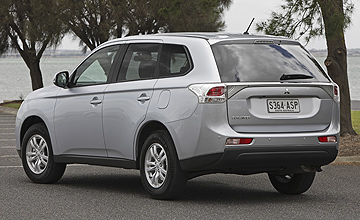BY MIKE COSTELLO | 11th Dec 2012

Mitsubishi has been very clear about what it thinks needed improving on its new Outlander compact SUV, a model that is crucial to the company achieving its lofty sales ambitions for 2013 and beyond.
Customers told the company that, while they liked the old model’s looks and space, the cabin refinement and quality left something to be desired. We at GoAuto agree with that assessment.
Thankfully, the new model has addressed these issues, with the new cabin a much more pleasant and quiet place to be – not to mention super-spacious in the back – and features a well-made and logical black-trimmed fascia and a lathering of soft-touch surfaces across all variants.
The mid-range LS is the pick with its well-integrated display and high-definition rear-view camera, plus comfortable cloth seats.
On the other hand, somewhat ironically, the nasty faux wood and aftermarket-style Rockford Fosgate screen in the flagship Aspire make the cabin look cheaper.
The Mitsubishi remains the only SUV among its rivals to come with seven seats and, unlike smaller crossovers like the Nissan Dualis, the two in the back are actually usable for people past the age of 18 months.
Furthermore, the middle row offers excellent headroom and leg space – although the lack of rear vents undoes some of the comfort – and the folding mechanism is quick, easy and leaves a flat loading floor. Full points for practicality.
Unfortunately, in several ways the new Outlander has retrograded, with less-interesting exterior styling and less cargo space than its predecessor. And the drive to boost rear seat space has evidently cut into front passenger room, since my 194cm frame almost touched the dash.
Mitsubishi has ditched the old split tailgate and raised the loading floor, and there is now nearly 25 per cent less rear cargo space with the back seats in place.
All variants have clever under-floor storage for the removable cargo cover, but the optional sub-woofer eats into this space. That means leaving it in the boot, which cuts into load space, or leaving it at home.
From behind the wheel, the Outlander is a mixed bag. It feels more nimble than before, with sharper turn-in, more feedback and a comfortable driving position, but doesn’t quite have the crisp handling of a Mazda CX-5 or Volkswagen Tiguan.
There’s a degree of bodyroll and understeer, but we found it relatively well controlled over twisting bitumen, and pliant and refined over gravel. Enhancing the relaxed feel were excellent dampers, plenty of suspension travel and an absence of wind and underbody noise.
The slimmer and high-profile 16-inch wheels on ES and LS models exhibited less tyre roar and had a softer ride than the larger, fatter 18s on the Aspire, but the flagship made up for this by offering more grip and a more ‘planted’ road feel.
Of the three engines, the new Mitsubishi 2.2-litre diesel was the highlight, with a decent torque band (above 2000rpm) and a remarkably quiet idle. This matches well to a conventional six-speed automatic transmission.
The fact that it consumes 40 per cent less fuel but produces more torque than the old V6 petrol that is has effectively replaced as the flagship engine option is more than handy, too.
But Mitsubishi’s diesel is less efficient than Mazda’s cheaper (albeit five-seat) CX-5 diesel, which uses less fuel (5.7L/100km) to make more power and torque (129 kW and 420 Nm).
The 2.4 petrol felt far from underpowered, but perhaps unsurprisingly also felt hobbled by the droning continuously variable transmission. Peak power arrives at a high 6000rpm and therefore requires the CVT to match revs at a higher point than is optimal for peace and quiet under acceleration.
It is hard to see the paddle-shifter manual mode as anything more than a gimmick, since the engine – while sprightly enough for typical SUV buyers – lacks the punch to accommodate sporty driving.
Two members of the media convoy managed to overheat the CVTs, sending them into a limp-mode. One faulty car is understandable, but two is questionable.
The front-drive model felt nippier than we expected, no doubt due to it being 100kg lighter. Despite its Lancer origins, the little 2.0-litre four-pot rarely felt overworked on the freeways and city streets it will undoubtedly call home. On hilly terrain, though, it tended to struggle.
The five-speed manual gearbox is the pick of the transmissions, with a light clutch, pleasant mechanical-feeling shift gate and – naturally – a more involving drive experience.
Belying its drab looks, the new Outlander is a big improvement over the old one in most ways. It has a spacious and well-made cabin, lots of equipment, a strong diesel engine and a class-leading warranty.
On the other hand, it has an average CVT automatic, less cargo space and a starting price above the arguably superior – or at least as good – Honda CR-V and Mazda CX-5. Furthermore, Mitsubishi has a new Subaru Forester and Toyota RAV4 to contend with from early next year.
Where the Mitsubishi makes the most sense is in the middle of the model range. The LS has the nicest cabin of the three variants, comes with diesel or petrol, and in all-wheel-drive guise has seven seats.
Buyers demanding seven-seat practicality should have a good look.
Further down the track (mid-2013), the plug-in hybrid PHEV version promises to bring to two the number of selling points unique to the diamond-badged brand.